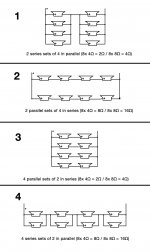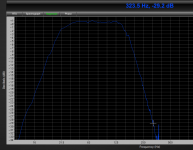Not sure about that. But I can report that the fault was a bad connector: with a new loom, all is good. Better than good: Scheme 3 (4x 16Ω series pairs in parallel) has improved LF significantly vs Scheme 1 (2x 2Ω sets in series of 4x drivers in parallel).
I will try rayma's extra wiring and report back....
I will try rayma's extra wiring and report back....
Not sure about that. But I can report that the fault was a bad connector: with a new loom, all is good. Better than good: Scheme 3 (4x 16Ω series pairs in parallel) has improved LF significantly vs Scheme 1 (2x 2Ω sets in series of 4x drivers in parallel).
I will try rayma's extra wiring and report back....
Can you describe in which way it sounds better?
If the drivers are all in one huge airspace, it will affect inter-driver electrical dampening how they're grouped. The two groups of parallel 4 in series may measure higher in Qts through increased Qes. The other scheme will have the individual woofer peaks combine into one wider peak, lowering measured and perceived Qts. Parallel operation eliminates most of the driver interaction, which retains a more focused, taller (higher Q) summed system peak. The series connection disperses the peak, making it sum as a wider (lower Q) peak.
Updated diagram attached, with corrections.
Thought it might be useful to fix and repost this graphic as I couldn't find a one-stop image showing all (4) possible connection methods for series-parallel wiring 8x drivers, which either produces 2*Re or Re/2.
Apologies in advance for another schoolboy question: but in each case where would resistors and capacitors be inserted to create a low-pass filter to roll off the response of 4 drivers to make a 2.5-way? And would this alter the impedance of the total load?
8 drivers playing the same tune is a recipe for failure, I've learned! The ideal two-way solution appears to be connecting 8x identical woofers W-W-M-M | T | M-M-W-W . . . low-passing the outer drivers to avoid comb filtering and mitigating rising response. I can see it might be better to treat it as a 3-way, but for this application I would like to use a 2-channel plate amp and a touch of additional filtering if possible.
Thought it might be useful to fix and repost this graphic as I couldn't find a one-stop image showing all (4) possible connection methods for series-parallel wiring 8x drivers, which either produces 2*Re or Re/2.
Apologies in advance for another schoolboy question: but in each case where would resistors and capacitors be inserted to create a low-pass filter to roll off the response of 4 drivers to make a 2.5-way? And would this alter the impedance of the total load?
8 drivers playing the same tune is a recipe for failure, I've learned! The ideal two-way solution appears to be connecting 8x identical woofers W-W-M-M | T | M-M-W-W . . . low-passing the outer drivers to avoid comb filtering and mitigating rising response. I can see it might be better to treat it as a 3-way, but for this application I would like to use a 2-channel plate amp and a touch of additional filtering if possible.
Attachments
Last edited:
Can you describe in which way it sounds better?
If the drivers are all in one huge airspace, it will affect inter-driver electrical dampening how they're grouped. The two groups of parallel 4 in series may measure higher in Qts through increased Qes. The other scheme will have the individual woofer peaks combine into one wider peak, lowering measured and perceived Qts. Parallel operation eliminates most of the driver interaction, which retains a more focused, taller (higher Q) summed system peak. The series connection disperses the peak, making it sum as a wider (lower Q) peak.
I'm seeing slightly more output around Fs. It's not a major audible difference, as I'm working with drivers of Fs=25-35Hz and unless you go looking for it, an extra 2dB from 25-30Hz isn't transformative in the average track. However with music that exposes the lowest octaves, I'm obviously hearing a little more robust response.
Also, would someone like to shoot down the idea of rolling off the response of the lowest driver in a '2.5-way' mechanically, rather than with a filter? Ie, sandwiching the driver with material that absorbs frequencies above the desired cut-off but passes lower ones intact? For instance, 50mm fibreglass sheets have an acoustic absorption coefficient that sucks up frequencies above 500Hz rather efficiently, but passes sub-200Hz almost untouched.
Hubsand,Also, would someone like to shoot down the idea of rolling off the response of the lowest driver in a '2.5-way' mechanically, rather than with a filter? Ie, sandwiching the driver with material that absorbs frequencies above the desired cut-off but passes lower ones intact?
I used some dense fiberglass rockwool to provide additional filtering on a 2x12" slot loaded sub (drivers facing each other) driven from the sub amp output of a Technics Dolby 5.1 receiver.
Built the sub around 2006, did the initial testing and addition of rock wool "by ear", but later did a measurement which shows the acoustic roll-off around 29dB per octave as can be seen in the screen shot below.
If I recall correctly the Technics sub output filter was near 200Hz, with only 12dB per octave rolloff, and the sub's slot created a nasty pipe resonance peak somewhere around 350Hz.
Far too much "junk" coming through the sub to combine well with the mains.
Passive crossover components to cross so low would have been very expensive and impossible to predict without accurate impedance measurement, so I experimented, and was quite happy with the results.
The rock wool appears to be adding the equivalent of a "two-pole" filter to the crossover, around 12dB per octave.
Art
Attachments
- Home
- Loudspeakers
- Multi-Way
- 4 ways with 8 woofers: Series/Parallel / Parallel/Series

